
by a zone or sash, commonly of silk, the manufacture
of the country, from the raw produce of China,
or imported ready made, Under the appellation of
chinde, from the peninsula of Hindustan.
The second great portion of dress is the coatt
called by the Malays baju, and by the Javanese
kdlambi and rasukan. It is of more various
forms than the preceding article, but may generally
be described as a frock with sleeves, longer or
shorter, according to the sex or nation of the
wearer. It seldom reaches below the hips, with
the Javanese men, and it has a row of buttons in
front, and with the women of the same tribe, it
is open only at the neck, slipping over the head in
putting it on. With the Malays of both sexes
the baju is entirely open in front.
The waistcoat of the man, or bodice of the
women, is of considerable variety. The Malay
one is, with the men, a tight vest, with a row of
buttons from top to bottom,—with the women a
plain unopen vest, intended to afford concealment
and some protection to the bosom. The sarung
very frequently covers the latter, reaching to beneath
the arms. With the male sex this portion
of dress is generally altogether wanting among the
Javanese, and the women of that nation supply its
place by a piece of cloth called a kdmban rolled round
the body and over the breasts, in such a manner as
to depress and ultimately to disfigure them. The
Sundas, or inhabitants of the western mountains of
Java, leave the bosom entirely naked, and experience
neither shame nor scandal from being seen
in this state of exposure.
The ancient practice of the Indian islanders
with respect to the head, appears to have been to
leave it uncovered ; the Balinese still adhere to
this practice. The Mahomedan tribes invariably
wear a slight covering in imitation of the turban
of the western nations. It is, as its name % implies,
a small handkerchief, which usually leaves
the crown of the head bare. On journeys a wide
umbrella hat is frequently used by all classes to
protect them from the sun.
The legs are always bare with both sexes, and
very commonly the feet too, though now and then,
in imitation of the Arabs, the men, among some of
the western tribes, wear sandals.
The Javanese, as in other matters, take the lead
in dress, and with them its refinements and extravagancies
are carried to the greatest excess. Besides,
their every day’s wear, they divide the male dress into
three descriptions, which they respectively denominate
rqjaputran, or the royal dress, pasoxvanan,
or the court dress, and prcjuritan, or the war dress.
The first is used by the sovereign on festive occa*
“ Saputangan, handwiper.”